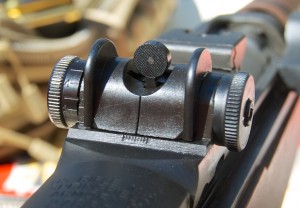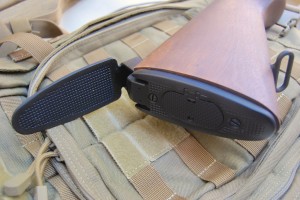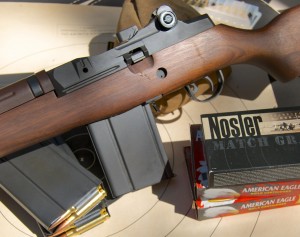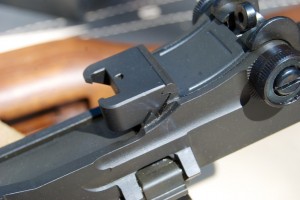The Springfield Armory M1A Standard Rifle
Tom McHale 04.16.13

This rifle is beast. Not a beast. Just beast. If you have teenage kids, you might have already heard things like video games, high school athletes, and cars described as “beast.” Apparently it’s a subtle, yet cool, form of praise. Kids these days don’t generally describe praise-worthy things as “richly robust with just the proper hint of panache.”
The Springfield Armory M1A Standard rifle is beast because of its homage (another non-teen word) to military history. The M1A is the Springfield Armory-produced “civilian” (semi-auto only) version of the battle-tested M14 rifle. The M14 was introduced to field use during the Korean war and is (roughly speaking) the next generation of the famous M1 Garand that had such a dramatic impact during World War II. In fact, the famous World War II general, George S. Patton, called the M1 Garand “the greatest battle implement ever devised.” We’re not exactly sure what actor George C. Scott had to say about it, but he did play Patton on TV.
After the war, the M14 brought a few changes to the M1 Garand. Select-fire capability, chambering in 7.62x51mm/.308, and a detachable box magazine to name a few. The M1A as a civilian rifle does not offer fully automatic capability, but maintains the detachable box magazine feature and chambers the .308 round. One other notable difference is the lack of a bayonet lug on the M1A. I know, it’s tragic, but it keeps the politicians from hemorrhaging bio-diesel. If you’re hell-bent on mounting an infantry charge down your street, you’ll just have to improvise with duct tape and a Ka-Bar knife.
A closer look at the Springfield Armory M1A Standard
| Safety first! Just like the M1 Garand, the Springfield Armory M1A uses a lever in the front of the trigger guard as the safety. As shown in this picture, the gun is on safe. Nudge the lever forward with the back of your knuckle and it will snap forward, out of the trigger guard, into the firing position. It’s the same basic mechanism used on the M1 Garand. Be careful with this type of safety–to put the rifle on safe, you’re pulling backwards with your trigger finger! Make sure you’re pulling the safety and not the trigger! | |
| The rear sight on the Springfield Armory M1A has a windage adjustment dial on the right and an elevation adjustment dial on the left. On the M1A Standard rifle, elevation and windage are adjustable in 1 minute of angle (about 1 inch at 100 yards) clicks. The windage dial gives you 16 clicks in either direction and you have sufficient elevation adjustment to compensate to about 1,100 yards. Springfield Armory includes a nifty article by Scott Duff and John Miller that tells you exactly how to properly zero your M1A. The elevation adjustment knob was tight, as to be expected and desired in my opinion. I found the windage elevation knob on the test rifle to be somewhat beyond tight, and I’ve been working out to get in shape for the upcoming Thumb Wars of the Stars special. I tried smothering it with Activia Butt-Modulating Yogurt to “loosen things up” but that didn’t seem to help. Don’t tell the folks at Springfield Armory, but I had to cover it with a cleaning rag and muscle it the first few times. Whatever you do, DON’T use pliers–this will almost certainly crack the adjustment dial. Don’t get me wrong, this adjustment should be firm and very deliberate as you don’t want it moving around on its own. Just be aware that there might be some break-in period required to get things loosened up. And it did loosen up with some use. Before venturing off to any foreign wars, be sure to try the adjustments and break in accordingly. | |
| The Springfield Armory M1A Standard rifle ships with a 10-round box magazine. You can order factory five- or 20-round magazines using the nifty Springfield Loaded Coupon that we’ll talk about in a minute. The magazine release lever is on the back side of the magazine well and releases the magazine when pushed forward. It’s about an inch-and-a-half forward of the safety lever, so you just barely have to adjust your grip to reach it with the firing hand. Seating a magazine in the M1A takes just a bit of practice. The easiest way is to insert it into the magazine well, angled backwards, and rock it into position. It sounds complicated, but is very smooth once you get the hang of it. And the magazine makes a satisfying click when it seats. You won’t be in doubt about its locked status. | |
 | The rear aperture sight features fine checkering on the back side to reduce glare. We found this to be a very useful feature! It’s one of those details that no one notices in the store, but really makes a difference on the range. Note the protective wings that help prevent the aperture sight from getting abused. |
| On the top of the receiver, at the back of the magazine well, you’ll see a stripper clip guide. While the M1A has detachable box magazines, it can still be reloaded with stripper clips from the top. We didn’t use this in testing, but know it’s there. In case you want to get super authentic. The dovetail for the stripper clip guide has a second use as a mounting point for the scope base. We’ll cover that in detail in the next article where we mount a rail base and scope to this M1A. | |
 | A sturdy sling mount is placed towards the front of the stock on the bottom side. It swivels back and forth, but not side to side. At the rear, just ahead of the rifle butt, is a similar, but fixed, sling mount. Somehow the Springfield Armory M1A Standard just screams for a traditional leather loop sling. No worries, you can get one cheap using the Springfield Loaded Coupon mentioned a little later! |
| Like the rear sight, the front post is protected by sturdy steel wings on either side. And the post is not a wimpy little AR-type either–it’s a steel blade that tapers like a wedge towards the front. This helps the post look sharp and crisp from the back. And it’s more aerodynamic when charging the trenches at a full run. The sight blade and wings assembly is movable side to side so you can zero the rifle (for windage) and have your windage dial on the receiver exactly centered. A hex locking screw keeps everything in place once you’ve got it set. One other thing to note about the front sight blade. Its width can be used for rough range estimation. It will exactly cover a 20-inch wide target at about 300 yards. | |
 | No, it’s not a collapsible bayonet to protect the rear flank. Nor does it make the M1A more aerodynamic, although you can probably use it while speed walking. But seriously, the fold-out butt plate has a purpose. You can lean it on top of your shoulder for a little extra stability. It’s an interesting feature, especially when shooting from a standing position or moving. It’s one of those things you just have to try to see if it works for you. |
| Unfortunately you can’t quite fit two rolls of Mentos breath mints in the stock storage compartments. However, you can fit the original Springfield Armory cleaning and oiling kit. The top hole is about 10 inches deep while the bottom one is about six-and-a-half inches deep. Why waste all that potential storage space in the stock? Later, we’ll mention some factory cleaning and maintenance supplies that will fit perfectly into these two chambers. | |
 | On the left side of the receiver is the bolt lock lever. If the magazine is in place, and empty, the bolt will lock back on its own. If you want it locked open while the magazine is out, or full, use the bolt lock lever. |
| About six inches behind the front sight is the gas port in the barrel and the gas tube below. The nut on the end is removable for cleaning and maintenance. The handy multi-purpose tool (discussed below) will remove this easily. Remember when cleaning that the gas system is supposed to be dry, so no oil or grease in there! |
Shooting performance
As the Springfield Armory M1A Standard comes with iron peep sights and no provision for mounting a scope without accessories, we’re not going to address accuracy in this article. Trying to do so would tell you more about the poor state of our eyesight than performance of this rifle! However, we have a second part of this article coming out shortly which details the process of mounting and using the optional scope mounting base. Once we get a scope mounted, we’ll do some accuracy testing with various .308 loads and report on the results.
We did shoot a variety of ammunition through the M1A for function testing and just plain fun. As you might expect from this design, digesting lots and lots of different ammunition was not a problem!
We shot and choreographed the following loads:
- American Eagle 7.62x51mm M1A – 2,637 feet per second (fps)
- Black Hills Match Hollow Point – 2,565 fps
- Nosler Match Grade 168 grain Custom Competition – 2,548 fps
- Winchester 120 grain PDX1 Defender – 3,034 fps
In addition to the factory loads, we assembled four different hand loads–all with 168 grain Sierra Matchking projectiles. We developed upper mid-range loads for 2,550 to 2,650 feet per second velocity performance using Hodgdon BL-C(2), IMR 4064, IMR 4895, and Ramshot TAC powders. We experienced no feed or function issues with any of the loads tested.
Felt recoil on this rifle was polite and relatively genteel, considering that it has a not-very-soft steel butt plate. Between the M1A’s 9.3-pound weight and gas-driven semi-automatic action, much of the perceived recoil is dampened.
Paperwork
The Springfield Armory M1A Standard Rifle arrives in a large cardboard box, which includes a variety of instruction paperwork and other extra-special surprises.
The nicest surprise was a printed “booklet bound” copy of the TM 9-1005-223-12 Department of the Army Technical Manual. Subtitled Operator and Organizational Maintenance Manual – 7.62mm Rifle M14 and Rifle Bipod M2, this 76-page booklet, dated January 1963, is the lightly burnt sugar on Creme Brûlée for any self-respecting gun geek.
Another bonus surprise is a reproduced article by Wayne Faatz entitled “The Mysterious Slam Fire.”
Springfield also includes a reproduced article by Scott A. Duff and John M. Miller. This one, “From the Bench – Zeroing M1 and M1A Service Rifles,” walks the reader through easy to understand instructions on how to zero either standard or National Match M1A rifles.
And another! As with all Springfield Armory products we’ve received, a M1A Loaded Coupon allows you to order accessories like extra magazines, cheek pieces, tools, cases, and M1A cleaning accessories at deeply discounted prices. The discount depends on the specific item, but most are available at 20% to 70% off retail. As an example, the Springfield Armory factory .308 20-round magazine sells for $37.50 instead of $54.95. Of course, most of the items on the list are available in third party manufactured versions, but if you want genuine factory accessories, take advantage of the one time use coupon. You can order as much as you want of each item–but one time only.
Oh, and a basic instruction book is included that covers operation, ammo information (mil-spec only recommended), cleaning, and basic maintenance.
Stripping and cleaning
The subtitle of this section got your attention didn’t it?
Sorry to burst your bubble, but we’re talking field stripping here–with the primary intention of cleaning and lubrication.
Basic takedown is simple. But first, remove the magazine, then check the chamber to make sure there is no cartridge there. Now check it again. Now flip on the safety just for good measure.
| The barrel and receiver assembly is locked into the stock by the trigger assembly. To remove the trigger assembly, pull the rear base of the trigger guard (where it meets the stock) towards the butt of the rifle. It will take some muscle! | |
| Pulling the trigger guard backwards will release it from a catch, allowing it to pivot towards the muzzle of the rifle. Pull it up all the way and the trigger assembly will come out in one piece. | |
| Now the barreled receiver will lift out of the stock. It may need a gentle nudge to get it moving. |
There you have it! This simple, no-tools, field strip procedure will give you pretty good access for basic cleaning and lubrication of the main parts.
Accessories and upgrades
Original cleaning kit

You can order an original military-style maintenance and cleaning kit and store just about all of it in the stock. Shown in the photo is a four-piece cleaning rod, M1A multi-purpose tool, ratcheted chamber cleaning brush, bore cleaning brush, and lubricant container. Pack that stuff into the stock compartments and you’ll have it when you need it!
Magazines
The rifle includes a single 10-round magazine, but you can order additional magazines from Springfield Armory in 5-, 10-, 15- and 20-round capacities. The 5-round magazine comes in a standard box configuration or a low-profile sporter configuration. Perhaps you want to hunt with your M1A? Check your state laws before trying to order different magazines!
Scope mounts
Springfield Armory offers two different receiver scope mounts for the M1A: one constructed of solid steel and the other aluminum. Both are custom designed to attach to the receiver on the left side and via the stripper clip guide dovetail at the rear. We obtained a steel scope mount and installed it with a Hawke Optics Sidewinder 30 10x scope. We’ll cover that in a follow up article. Springfield Armory also offers a Scout Scope forward mount.
Other
Given the history of the M14 platform and Springfield Armory’s adherence to the core original design, a number of other accessories are readily available from Springfield and third party vendors. Cheek rests, replacement match sights, tritium night sight posts, muzzle brakes, and more can all be found at Brownells.com.
Closing arguments

The Springfield Armory M1A Standard rifle is, well, kind of nostalgic. True to the basic M1 Garand and M14 military rifle design, it’s a sturdy and reliable war horse. The iron sights feel natural and are quite effective. A good rifleman is expected to hit targets out to 500 yards with them. We’re going to add a scope for fun and some accuracy testing, but odds are, the scope will come off as soon as we’re finished. Somehow, adding optics to this gun just seems wrong and unnecessary.
We loved the Springfield Armory M1A Standard. From its walnut stock to iron sights to classic action design, it’s a natural combination of form, function and fun.











